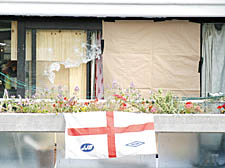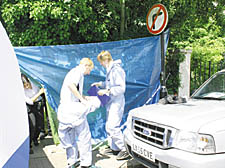
The smashed window of the murder victim’s flat |
From an estate to leafy streets, a home is no longer a castle for cruel killers
Special Investigation: Two murders and another suspected see police hunt possible revenge gang and fraudsters who know no boundaries
NEIGHBOURS have spoken of their shock after a gang smashed their way into a flat in the early hours of Sunday and stabbed the man inside to death.
The residents, on the Rowley Way estate in Abbey Road, West Hampstead, said they were woken to the sound of breaking glass, little knowing they were hearing the last moments of the 49-year-old man who has yet to be named.
Police rushed to the scene to find the man still alive at 2.40am although he was later pronounced dead in the Royal Free Hospital, Hampstead.
A post mortem on Tuesday at St Pancras Mortuary, found he had died from stab wounds.
Police are still looking for clues at his flat but three men picked up on Sunday morning, arrested on suspicion of murder, have been bailed. Another man was released without charge.
A witness who lives nearby described waking up to see six men smashing through the victim’s window. He said: “It woke me up. I heard smashing and crashing and saw people trying to access his flat but I never heard him call out once.
“I went out to the balcony in my underpants and all I could see was young lads jumping onto his balcony and smashing windows with lumps of wood and metal.”
Residents on the award-winning estate, which has Grade-II listed building status, spoke of a close knit community that struggles with intimidating gangs of teenagers who loiter and commit petty crime. No one expressed surprise at the victim’s killing.
Many residents feel the council has neglected them, and insist CCTV, which is around eight years old, hasn’t worked for a number of years – although the council deny this. One man, who described the victim as a “peaceful, lovely guy”, said the estate was not safe for strangers at night.
Another neighbour said the victim lived on sickness benefit and was a familiar sight to residents as he made his way to the local shop to buy beer, some food and a newspaper. He added: “Kids hang around at night to rob people.”
A mother-of-three criticised the council for housing too many people with social problems, such as drug addicts and alcoholics, in Rowley Way, and complained about teenagers’ aggressive dogs. She claimed youngsters hide weapons in her flowerbeds.
Witnesses have described a group of men who hounded the victim in the two weeks before they killed him, and beat him up a day before he died.
In a bizarre twist, the BBC crime drama Waking The Dead began filming at the estate on Monday.
Kilburn Lib Dem councillor David Abrahams said the murder has highlighted the need for residents and council members to talk about security, but added he thought the murder had been an unavoidable, isolated incident.

Police forensic teams hunt for clues |
THE body of a wealthy elderly recluse – who may have been murdered – had been decaying under piles of papers in his Hampstead home for a month, police have revealed, writes Mairi MacDonlad.
A murder enquiry was launched after 86-year-old Allan Chappelow’s body was discovered by police at his rundown villa in Downshire Hill last Wednesday.
This week police confirmed they were following a possible line of enquiry that Mr Chappelow was killed by thieves who broke into his house and stole his identity, skimming his account of thousands of pounds.
Mr Chappelow had lived at the same house since he was 14 when he moved there with his family.
He became an accomplished writer whose biography of the playwright George Bernard Shaw, Shaw the Villager and Human Being, was published in 1961.
He was also a freelance photographer and worked for the Daily Mail during the 1950s.
Few of his neighbours knew Mr Chappelow, who had been a recluse for decades, but he was often seen riding his motorbike and was a regular visitor to Heath Library in Keats Grove.
Detective Chief Inspector Peter Landsdown of the serious crime squad said he believed Mr Chappelow had been dead since May.
A relative said he believed police visited the Grade II-listed property looking for Mr Chappelow twice before his body was found.
The house, which is well known in the area for its dilapidated state in a street where homes sell for more than £2 million, was “packed with stuff that he’s collected over the years”, according to DCI Landsdown.
A post mortem at St Pancras Mortuary on Saturday gave the cause of death as head injuries.
This was confirmed by DCI Landsdown at an inquest opened at St Pancras Coroners Court on Monday.
Mr Chappelow’s name and date of birth were given by coroner Dr Andrew Reid. He told the court that other information would be withheld to avoid interfering with the police investigation.
The alarm was initially raised by his bank which had noted unusual transactions of around £10,000.
Nigel Steward, a Safer Neighbourhood co-ordinator in Hampstead said there had been a spate of thefts of personal documents and letters from recycling bins recently.
A relative, James Chappelow who lives in Hertfordshire, said that on the only occasion he had attempted to visit him in Downshire Hill in the 1970s, Allan Chappelow had refused to open the front door.
James Chappelow said Allan’s brother had died during the 1950s and he had lived alone since, speaking to few people.
His optician at JL Opticians in Camden High Street said Mr Chappelow last visited on March 17.
Montague Levy said Mr Chappelow’s photography background made him an awkward customer to deal with.
Mr Levy said: “Because he was a photographer and he thought he knew about focal length he tried to tell us what to do with his spectacles. So much against my better judgement I made them to his specifications. I had to redo them three times to his specifications and he wouldn’t pay any more for it. He was a pleasant enough man but he thought he knew more about optics than we did.”
Mr Levy added that Mr Chapplow was intelligent and “very much together” but poorly dressed for a man of his considerable wealth.
Neighbour Peter Tausig who knew Mr Chappelow for some 10 years said he was one of the few people he spoke to.
He said: “He always had gripes about his neighbours, the council or the post office and would regularly fire off letters to them all.”
He added Mr Chappelow proudly described his house as “a little piece of history” and resented change of any sort.
Mr Chappelow’s early 19th-century villa was on English Heritage’s Buildings At Risk register and was graded priority C, meaning ‘slow decay; no solution agreed’.
Described by neighbours as eccentric and “not of this world” he was known to have stuck broken tiles on his roof together with cellotape.
DCI Landsdown said he believed Mr Chappelow’s body was lying in the house since May. He added that it took two days to recover the body due to conditions inside the house, which was full of belongings collected over the years.
Ruth Montague, of Friends of Keats Grove, said: “His father was very similar – sometimes I couldn’t tell them apart. He didn’t want to stop and talk to people and no one really knew him very well.
|